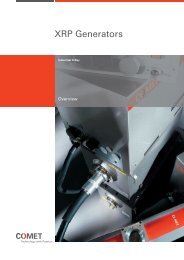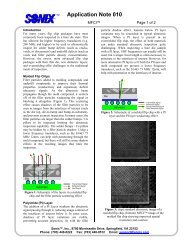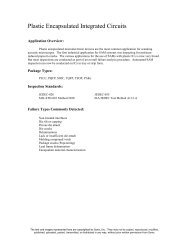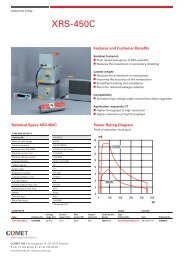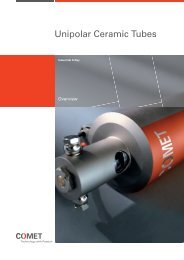JSR DPR300 Operator Manual - INSIDIX, Non-Destructive Testing
JSR DPR300 Operator Manual - INSIDIX, Non-Destructive Testing
JSR DPR300 Operator Manual - INSIDIX, Non-Destructive Testing
You also want an ePaper? Increase the reach of your titles
YUMPU automatically turns print PDFs into web optimized ePapers that Google loves.
4 General Description4.1 DescriptionThe <strong>DPR300</strong> is a general-purpose ultrasonic pulser/receiver that can be configured for a wide rangeof uses. In addition to describing available <strong>DPR300</strong> features and options, this manual indicates thedifferences between the available <strong>DPR300</strong> configurations.The <strong>DPR300</strong> can be configured during manufacture as a pulser/receiver with manual-only control,PC control, or simultaneous manual and PC control. For <strong>DPR300</strong> units populated with both frontpanel and remote PC controls, the instrument responds to both sets of controls, and each instrumentfunction will be set to the value most recently received from the front panel or remote command.The <strong>DPR300</strong> receiver is available in 35MHz and 50MHz bandwidths, and the <strong>DPR300</strong> pulser isavailable in 475V and 900V amplitude ranges. Users should familiarize themselves with theoperational limits of <strong>DPR300</strong> pulsers that have the 900V option installed by reading about the PRFcommand in Section 6 of this manual.In a typical <strong>DPR300</strong> application, the <strong>DPR300</strong> pulser produces a high voltage electrical excitationpulse and applies this pulse to the instrument’s T/R connector. An ultrasonic transducer connectedto the T/R connector via a length of 50 Ω coaxial cable is then employed to convert the electricalenergy of the excitation pulse into an ultrasonic pulse that is propagated into a test material ormedium. Four energy levels, sixteen amplitude levels, and two pulser-impedance values offered bythe <strong>DPR300</strong> enable the user to adjust the characteristics of the excitation pulse to the specifictransducer employed. Sixteen discrete damping levels in the <strong>DPR300</strong> allow the transducer responseto be adjusted over a wide damping range.With the <strong>DPR300</strong> configured for pulse-echo mode operation, acoustic echoes reflected frominterfaces or defects within the test material are converted by the transducer into electrical signalsthat are presented to the T/R connector of the <strong>DPR300</strong>. The low-noise <strong>DPR300</strong> receiver amplifiesthese electrical signals, and the signals then pass through adjustable high pass and low pass filters.The <strong>DPR300</strong> receiver gain is adjustable between -13 dB and 66 dB, and there are six high pass andsix low pass filter settings for band-limiting the receiver frequency response. The amplified andfiltered signals are available on the instrument’s Receiver Output connector.The <strong>DPR300</strong> may also be used in transmission mode operation wherein a separate receivingtransducer is used to detect acoustic pulses that have propagated through a test material or medium.This second transducer is connected to the <strong>DPR300</strong> receiver Through connector, and the receivedsignals are processed as described above for pulse-echo mode operation.The <strong>DPR300</strong> allows external equipment such as A/D digitizer boards or oscilloscopes to besynchronized to the pulser operation. To facilitate this, a synchronization pulse applied to theTrig/Sync connector can be employed to trigger the pulser when the instrument is in external triggermode. Alternatively, when the <strong>DPR300</strong> is configured for internal-trigger mode, a short pulse isoutput on the Trig/Sync connector simultaneous with the generation of the excitation pulse. Allconnectors on the <strong>DPR300</strong> are BNC-type with the exception of the computer interface connectors.Imaginant Inc. <strong>DPR300</strong> Ultrasonic Pulser/Receiver 6




